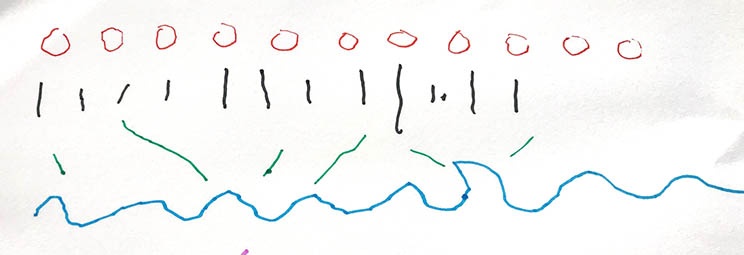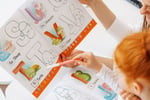
In an increasingly digital age, it's easy to view handwriting as a dying art. Few people own fountain pens; most written correspondence is tapped directly into devices. In Finnish schools, children are no longer taught cursive (joined-up) writing but move straight to keyboards two years after learning their letters.
Yet writing by hand is a complex craft that exercises visual, memory and fine-motor skills. It helps children remember spelling and develops their phonics skills. Older children recall facts and information better through the process of writing out notes by hand; brain imaging studies show that cursive writing, in particular, activates parts of the nervous system that typing does not. Our brains appear to work harder and process information at a deeper level when we write things down.
Writing fluidly
Children need to develop fluency in their handwriting in order to concentrate on what they are writing, rather than the act of writing itself. Without this automaticity, the process of writing will distract a child from their composition. Fluency is far more important than neatness. How can parents help their children develop this skill?
1. Make it personal
When your child first learns to write, start with the thing most personal to them - their name. Get them to trace, copy, decorate, paint it, join dot-to-dot letters etc until it's second nature. Then introduce family names, pet names - things that matter to them. Repetition is key.
2. Practice letter shapes and movements
Focus on the movement used to create letters, rather than just copying and tracing. It is as important to know how letters are formed as what they look like. If a child gets into the habit of starting 'p's at the bottom or going clockwise with their 'o's they will find it difficult to write fluidly and will struggle to join up their writing later on. Demonstrate the direction the pencil moves to make a letter.
For preschoolers and Preps, practice the drawing movements they need for writing:
- anti-clockwise circles (practice for a, c, d, e, g, o, q)
- clockwise circles (b, p)
- straight lines, starting at the top (b, d, f, h, i, j, k, l, p, q, r, t)
- diagonals (k, q, x, v, z)
- curves and wiggles (s, k, g, y, f, j, m, n, r, u, w)

Don't worry about size or neatness at this stage. Use different media to reinforce technique - draw in sand, shaving foam, steamy windows and flour, finger paint, use chalk, markers, crayons, pencils or try an app like Writing Wizard or Eggy Alphabet.
Strengthen little hands
Use complimentary activities to strengthen hand muscles and develop fine motor skills, eg:
- play dough
- cutting
- drawing
- colouring-in
- tracing
- piano playing
- sewing
Little and often
Better to practice five minutes every day than do a long 30 minute session. Learning to write can be fantastically boring and frustrating for many children so do short 'blasts' of practice, eg how many times can they write a specific letter or word in 30 seconds? Don't focus on neatness so much as proper shape formation and movement.
Provide a visual aid

Make sure your child has a visual aid when practising their writing, should they need a reminder. The example above shows children where to put their pencil to start the letter with a second red dot to indicate of the direction they need to move to form the letter. You can buy handy rulers or work mats with beginner's letters on, or print a visual aid off the internet. Your child's school/preschool should also be able to provide you with something you can use at home.
Use 'real life' situations
Try and weave writing tasks into your family's day-to-day, eg
- Shopping lists
- Writing birthday cards
- Labelling
- Filling in forms
- A home chores roster for your children have to sign when they have completed their tasks.
- Jotting down family members' choices before ordering at a café.
- Use a family whiteboard to leave notes for each other
Experiment and have fun
Let your child explore different media - coloured pens, markers and white board, chalk and blackboard, black paper with white pen, highlighters, paint etc. My kids loved writing secret messages to each other with 'magic ink' pens where the writing only showed up under ultraviolet light. Go old school and get your child to write 'invisible' messages in white crayon on white paper. Paint over the paper with watercolour paint to reveal the message.
Encourage and reward
Perseverance is key to a child's success in writing but learning to write can be an emotional rollercoaster for many children. Nurture a positive attitude to help develop their confidence.
- Praise and encourage but hold back on the superlatives. It's not helpful to tell a child that everything s/he does is 'wonderful', 'fantastic', 'amazing'.
- Praise your child's effort.
- Be specific with your feedback - for example, "your 'k's look neat" doesn't give your child any useful information, whereas "Your 'k's are at the same height as your other tall letters and you started the loop beautifully at the half-way point here. Well done!" is more constructive.
- Ask your child to assess their own work. Which part of their writing did they do well? Where did they struggle? Is there anything they would like some help with?
- Don't compare their writing with others'. Do compare their writing with previous work they have done, where there is an improvement. It is important they recognise and acknowledge their achievements.
- Talk about the content of their writing, not just what it looks like. Show interest in their thoughts and ideas.
- Display good work somewhere prominent, eg on a wall or on the fridge as a sign of your appreciation.
- If your child has worked very hard at their writing, consider rewarding them with a special novelty pen, ruler or notebook. Make sure they know you are rewarding them for their hard work rather than the writing itself.










